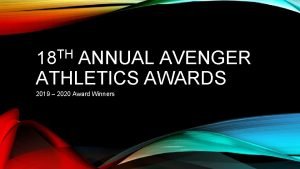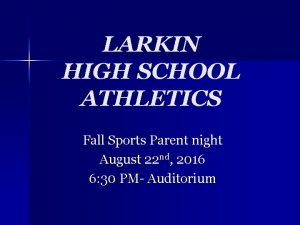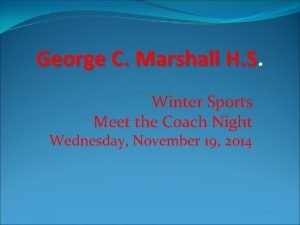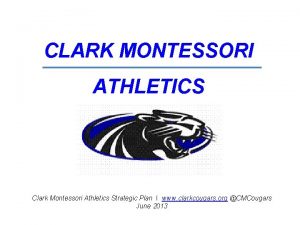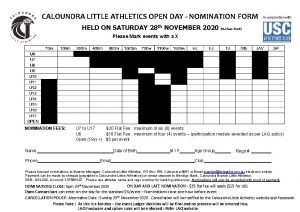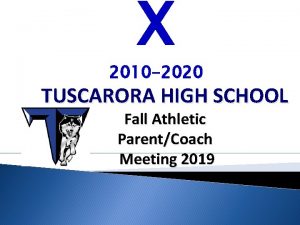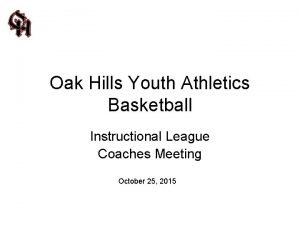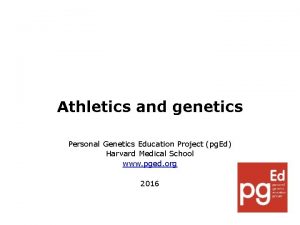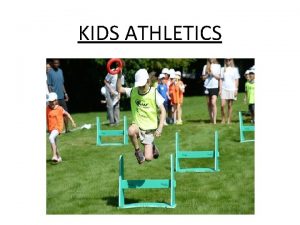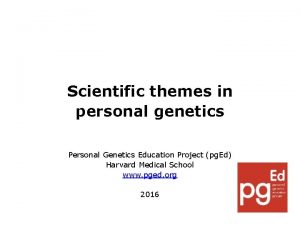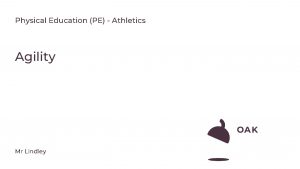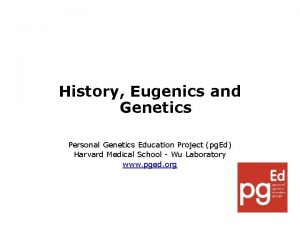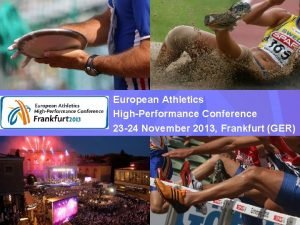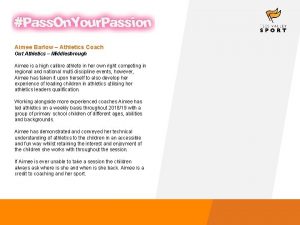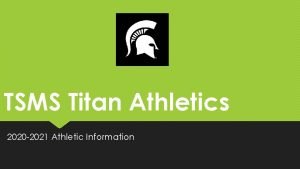Athletics and genetics Personal Genetics Education Project pg
















- Slides: 16

Athletics and genetics Personal Genetics Education Project (pg. Ed) Harvard Medical School www. pged. org 2016

Do Now Answer the following questions: 1. Do you wish your parents had genetically tested you as a child to see if there is a certain sport at which you might excel or to see if you might have a special gift for music? Why or why not? 2. What could be a benefit and what could be a disadvantage to having genetic analysis of this sort performed at an early age?

How do genetic testing and athletics intersect? • Genetic testing is being used to predict injury risk and to detect medical conditions with the aim of preventing harm to athletes. • Companies offer testing to help parents and children use genetics as part of the puzzle in deciding what sport to pursue. • The role of genetic testing in sports presents a number of personal and societal questions in need of attention.

Protecting Athletes: Sickle Cell Trait (SCT) Ereck Plancher Dale Lloyd II Healthy round red blood cells and a sickled cell “In N. C. A. A. , Question of Bias Over a Test for a Genetic Trait” -- Headline from The New York Times, Apr 11, 2010 Images: (left) Naples News, (center) Rice University, (right) Wellcome Images

Protecting Athletes: Hypertrophic Cardiomyopathy (HCM) Causes of sudden cardiac death in young athletes: HCM 36% • How do we decide to screen for conditions that may put an athlete’s health or life at risk? • How common or risky does a trait need to be before we screen everyone? Data from BJ Maron et al (2009)

What can a genetic test for “sports ability” tell us?

Direct-to-consumer genetic testing for sports • Companies are currently selling tests that to try to predict a person’s risk for sports injuries and athletic abilities. • Target audiences are athletes of all ages, parents, coaches and trainers. • There is controversy about how predictive these tests are and what else these tests may reveal about a person’s health.

Genes linked to athletic performance and injury risk • A common version of ACTN 3, the so-called “speed” gene, has been linked to sprinting ability. • Preliminary studies have linked a common version of the APOE gene, called APOE 4, to increased risk of severe effects from a concussion. • On-going research is exploring the link between versions of the collagen-producing genes, COL 5 A 1 and COL 5 A 2, and increased risk of Anterior Cruciate Ligament (ACL) tears.

The ACTN 3 gene and its link to speed • The gene, ACTN 3, produces a protein that helps fast-twitch muscle fibers to contract. • There is a version of ACTN 3 that has been linked to sprinting ability. • ~95% of elite sprinters have at least one copy of this version of the gene. • ~80% of people in the general population also have at least one copy of this version.

The APOE gene and concussion recovery • Some companies test for “concussion complications risk” – looking at the E 4 version of the APOE gene • APOE 4 is also linked to an increased risk of Alzheimer’s disease • Should companies reveal this link to customers or is it a customer’s responsibility to research this link?

Michael Phelps & Usain Bolt: Karen Blaha, CC BY-SA 2. 0 What has led them to excel? Photo. Bobil, CC BY 2. 0

What leads to excellence in sports: Genes? Environment? Training? Drive? Duluoz Cats, CC BY-NC-ND 2. 0 Edwin Martinez, CC BY 2. 0 “Born to win: top athletes don’t share a single talent gene, but hundreds of them” -- Headline from The Conversation, June 25, 2015

Why can US Olympian Jennie Finch strike out top Major League Baseball players with a much slower pitch than they typically hit? By Gary Leland, via Wikimedia Commons

Discussion questions • How effective might genetic analysis be in predicting athletic performance? • Should genetic analysis be used to screen athletes for health conditions? Why or why not? • From a scientific perspective, what are the most important facts when examining the link between athletic performance and genetics? • What should a family consider when a child is thinking about playing a contact sport? How can genetic information both illuminate and complicate how parents decide what is right for their children?

Image credits Slide 4: (left) “Ereck Plancher. ” Via the Naples News (http: //www. naplesnews. com/community/family-of-ereck -plancher-to-file-wrongful-death-suit-against-ucf-ep-401384505 -332397412. html, accessed Mar 1, 2016). Slide 4: (center) “Dale Lloyd, ” Rice University (http: //www. riceowls. com/sports/mfootbl/mtt/lloyd_dale 00. html, accessed Mar 1, 2016). Slide 4: (right) “SEM sickled and other red blood cells, ” EM Unit, UCL Medical School, Royal Free Campus, Wellcome Images, B 0000521 (http: //tinyurl. com/hmutpf 3, accessed Mar 1, 2016). Available under a Creative Commons Attribution-Non. Commercial-No. Derivatives 4. 0 International license (https: //creativecommons. org/licenses/by-nc-nd/4. 0/). Slide 6: Personal Genetics Education Project (Patricia Hautea) Slide 7: Personal Genetics Education Project (Patricia Hautea) Slide 8: Personal Genetics Education Project (Patricia Hautea) Slide 10: Personal Genetics Education Project (Dana Waring) Slide 11: (top): “Michael Phelps in the 400 m IM” by Karen Blaha (https: //www. flickr. com/photos/vironevaeh/2272442948/, accessed Jan 26, 2016). Available under a Creative Commons Attribution-Share. Alike 2. 0 Generic license (https: //creativecommons. org/licenses/by-sa/2. 0/). Slide 11: (bottom): “Bolt” by Photo. Bobil (https: //www. flickr. com/photos/15174316@N 02/2818731283/, accessed Jan 26, 2016). Available under a Creative Commons Attribution 2. 0 Generic license (https: //creativecommons. org/licenses/by/2. 0/). pg. Ed cropped this image. Slide 12: (left): “I got it” by Duluoz Cats (https: //www. flickr. com/photos/duluoz_cats/382133495/, accessed Jan 26, 2016). Available under a Creative Commons Attribution-Non. Commercial-No. Derivs 2. 0 Generic license (https: //creativecommons. org/licenses/by-nc-nd/2. 0/).

Image credits Slide 12: (right) “US Open 2013 Part 2 668” by Edwin Martinez (https: //www. flickr. com/photos/rhythmstrip/9630783949/, accessed Jan 26, 2016). Available under a Creative Commons Attribution 2. 0 Generic license (https: //creativecommons. org/licenses/by/2. 0/). Slide 13: “Gary Leland Interviews Jennie Finch” by Gary Leland [Public domain], via Wikimedia Commons (https: //commons. wikimedia. org/wiki/File: Gary_Leland_Interviews_Jennie_Finch. png, accessed Mar 3, 2016). References Slide 4: (headline) “In N. C. A. A. , Question of Bias Over a Test for a Genetic Trait” by Katie Thomas and Brett Zarda, The New York Times, 2010 (http: //www. nytimes. com/2010/04/12/sports/12 sickle. html, accessed Jan 12, 2016). Slide 5: (data source) BJ Maron et al. 2009. Sudden Deaths in Young Competitive Athletes: Analysis of 1866 Deaths in the United States, 1980– 2006. Circulation. 119: 1085 -1092. doi: 10. 1161/CIRCULATIONAHA. 108. 804617 (http: //circ. ahajournals. org/content/119/8/1085. long, accessed Jan 26, 2016). Slide 12: (headline) “Born to win: top athletes don’t share a single talent gene, but hundreds of them” by Colin Moran, The Conversation, 2015 (https: //theconversation. com/born-to-win-top-athletes-dont-share-asingle-talent-gene-but-hundreds-of-them-43816, accessed Jan 26, 2016).
 Do athletics or play athletics
Do athletics or play athletics Wayland union schools athletics
Wayland union schools athletics Apache athletics
Apache athletics Avenger athletics
Avenger athletics Oakton high school athletics
Oakton high school athletics Leicester high school athletics
Leicester high school athletics Larkin athletics 8 to 18
Larkin athletics 8 to 18 Iaaf kids’ athletics
Iaaf kids’ athletics Half hollow hills athletics
Half hollow hills athletics George c marshall high school athletics
George c marshall high school athletics Dekalb county schools athletics
Dekalb county schools athletics Clark montessori athletics
Clark montessori athletics Caloundra little athletics
Caloundra little athletics Bruton high school athletics
Bruton high school athletics Bow high school athletics
Bow high school athletics Tuscarora high school athletics
Tuscarora high school athletics Ohya basketball
Ohya basketball



